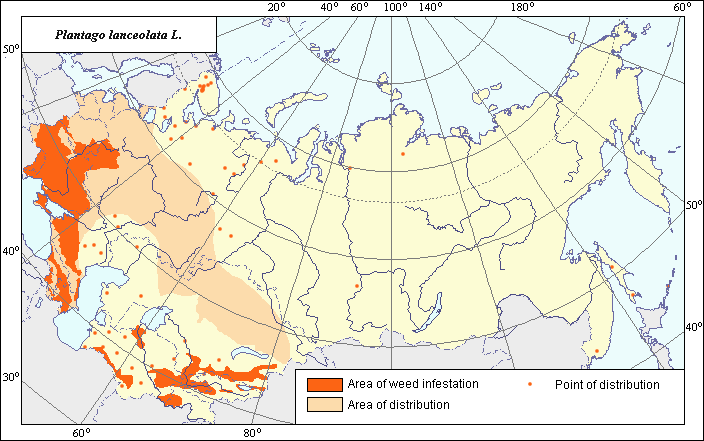Weeds
Area of distribution and weediness of Narrow-leaved Plantain (Plantago lanceolata L.)
 Object description Download GIS-layers
Object description Download GIS-layers
Authors:
Object specialist I.N. NadtochiiGIS-specialist I.A. Budrevskaya
Date of creation:
14.04.2005Scale:
1:20,000,000.Accuracy of map:
Map was created using information from state publications and maps of natural scale 1:80,000,000-1:5,000,000.Projection:
"Alber's Equal Area Conic for the USSR", 9, 1001, 7, 100, 0, 44, 68, 0, 0.Basic contents:
Vector map. Main distribution area is shown by polygons, while sporadic distribution is shown by points. Zone of weediness is shown by a polygon.Accuracy of classifier:
Distribution area of the species is divided into zones of main distribution, weediness, and sporadic distribution. Zone of weediness was allocated according to criteria of occurrence (% of fields where this species is found) and abundance (expressed as projective cover of this species in the field) (Tanskii et al., 1998), i.e., where the occurrence of this species exceeds 50% with an abundance (projective cover) of more than 15%.Mapping procedure:
Distribution area and zone of weediness were mapped following an analysis of references and public cartographic materials. The map by Hulten & Fries (1986) was used as a prototype; the southern border was corrected along zones of deserts and semi-deserts. In Central Asia, the distribution area was allocated on arable lands, as published literature contains records of the Narrow-leaved Plantain in fields in Turkmenistan (Nikitin, 1957), Uzbekistan (Khalilova, 1975), Tajikistan (Vasil.chenko, 1955), and Kyrgyzstan (Sukhin et al., 1983). Places of sporadic distribution were allocated according to Hulten & Fries (1986), Poyarkova (1966), and Tolmachev (1977). The zone of weediness was mapped using published data and the map of arable lands. Further research revealed that the weed is the most widespread weed in Ukraine (Mel.nichuk & Kovalivs.ka, 1972); a weed of grain crops in the Brest and Gomel Regions (Kozlovskaya & Simonovich, 1966); a weed causing harm to perennial grasses in the Mogilev Region (Protasov, 1974); a weed with an abundance of 3-4 points in clover crops and mixed grasses in the western areas of the Non-Chernozem Zone (Shlyakova, 1982); a field weed in perennial grasses in the Smolensk, Kaluga, and Bryansk Regions (Korovina, 1982); the main weed in the Stavropol Territory (Dokuchaev et al., 1973); a weed in areas of irrigated agriculture in European Russia, the Caucasus, and Central Asia (Vasil.chenko, 1975); a weed in wheat crops in Central Asia and the Caucasus (Korovina, 1981); a weed with an abundance of 2-3 points in Azerbaijan (Doronina, 1978) and the Tashkent Region of Uzbekistan (Khalilova, 1975); a frequent weed in lucerne crops in Turkmenistan (Mal.kov, 1936; Nikitin & Gel.dikhanov, 1988); and a weed with an abundance of 3 points in Kara-Kalpakstan (Sukhin et al., 1983).Sources of data:
Dokuchaev, V.M., ed. 1973. Green Enemies: Weeds of the Stavropol Territory and their control. Stavropol: Stavropol. Publishing House. 168 p. (in Russian)Doronina, Yu.A. 1978. Weed plants of dry subtropical areas of Azerbaijan. In: Brezhnev, D. D., ed. Byulleten. VIR. Leningrad: VIR, p. 82-86 (in Russian).
Hulten, E. & Fries, M. 1986. Atlas of North European Vascular Plants, North of the Tropic of Cancer: Konigstein. V. 1-3. 1172 p.
Khalilova, M.KH. 1975. Some data on weeds in grain crops of Tashkent Region. In: Belova, A.I., Burygin, V.A., Kamilova, F.G., eds. Proc. of Tashkent SKHI. Tashkent: Tashkent SKHI. V. 43, p. 41-50 (in Russian)
Korovina, O.N., ed. 1981. Weed plants of wheat sowings in the USSR. In: Catalogue of VIR world collection. N 320. Leningrad: VIR, 68 p. (in Russian).
Korovina, O.N., ed. 1982. Weed plants of the Non-Chernozem Zone of Russia. In: Catalogue of VIR world collection. N 338. Leningrad: VIR, 117 p. (in Russian).
Kozlovskaya, N.V. & Simonovich, L.G. 1966. Features of weed distribution on turfy-podzol soils of Polesye region. In: Yurkevich, I.D., ed. Geobotanical research. Minsk: Nauka i tekhnika: 56-64. (in Russian).
Mal.kov, F.I. 1936. Main weeds of Turkmenistan and their control. Leningrad: VASKhNIL. 48 p. (in Russian).
Melnichuk, O.S. & Kovalivska, G.M. 1972. Atlas of the most widespread weeds of the Ukraine. Kiev: Urozhai, 204 p. (in Ukrainian).
Nikitin, V.V. & Geldikhanov, A.M. 1988. Keys to plants of Turkmenistan. Leningrad: Nauka. 680 p. (in Russian).
Nikitin, V.V. 1957. Weed vegetation of Turkmenia. Ashkhabad: AN TurkmSSR, 581 p. (in Russian).
Poyarkova, A.I., ed. 1966. Flora of the Murmansk Region. V. 5. Moscow & Leningrad: AN SSSR, 551 p. (in Russian).
Protasov, N.I. 1974. Segetal weeds of Mogilev Region. In: Ways of field crop yield increase. V. 5. Minsk: Urozhai. p. 126-128 (in Russian).
Shishkin, B.K., ed. 1963. Botanical atlas. Moscow & Leningrad: Izd-vo sel.skokhozyaistvennoi literatury, zhurnalov i plakatov, 504 p. (in Russian).
Shlyakova, E.V. 1982. Field-weed plants of the Non-Chernozem zone of RSFSR. Leningrad: Kolos. 208 p. (in Russian).
Sukhin, V.S., Moiseeva, T.M., Vasyuta, Z.R. 1983. Weed vegetation of Kyrgyzstan. Frunze: Kirghiz Agricultural Institute. 83 p. (in Russian).
Tanskii, V.I., Levitin, M.M., Ishkova, T.I. & Kondratenko, V.I. 1998. Phytosanitary diagnostics in integrated management of cereals. In: Novozhilov, K.V., ed. Compendium of methodical recommendations in plant protection. St. Petersburg: VIZR, p. 5-55. (in Russian).
Tolmachev, A.I. ed. 1977. Flora of North-East of the European part of the USSR. Leningrad: Nauka. V. 4. 312 p. (in Russian).
Vasilchenko, I.T. & Pidotti, O.A. 1975. Keys to weed plants of areas of irrigated agriculture. Leningrad: Kolos. 375 p. (in Russian).
Vasilchenko, I.T., ed. 1955. Weed plants of Tajikistan. V. 2. Moscow-Leningrad: USSR, 321 p. (in Russian).
Right and copyright:
All rights reserved. Copyright 2005 © I.N. Nadtochii & I.A. Budrevskaya.Picture taken from monograph edited by B.K. Shishkin (1963).

